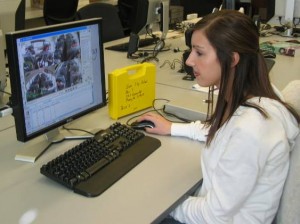
TUSCALOOSA, Ala. – The University of Alabama’s University Transportation Center for Alabama is processing and finalizing the research data of the pilot study assessing the impact of the installation of lap/shoulder seat belts on a limited number of Alabama school buses.
The study will provide information about school buses with seat belts for possible adoption throughout the state and the nation.
With 12 new school buses from 10 local school systems equipped with various types of three-point seat belts, the project involved four areas of research: review of national experiences and trends, alterations needed in the Alabama bus fleet if seat belt use is adopted, analysis of Alabama school bus crash data, and a cost-benefit analysis.
Each of the new school buses was outfitted with four ceiling-mounted video cameras allowing the research team to gather data on the level of restraint use, review the percentage of students using the belts and the percentage of students using the belts properly, and to investigate if using the belts keeps students from moving into the aisle and out of the protective compartment provided by the seats. The camera data will also reveal the benefit of having a bus aide to monitor students and will monitor time devoted to buckling at each stop.
Dr. Dan Turner, professor of civil engineering and the principal investigator of the research team, explained that the detailed results will not be released until the study is completed, so that the seat-belt use does not arbitrarily change as the result of a news article. That would make it impossible to measure the effectiveness of experimental safety treatments.
“There is a genuine excitement in trying different safety ideas to improve the use of belts in school buses,” said Turner. “Even though we cannot release actual findings at this time, we are looking to the future and anxious to reach the goals we set for ourselves three years ago when the study began.”

The study results will be sent to the Alabama State Department of Education, Gov. Bob Riley, and the Seat Belt Pilot Study Group before being released to the general public.
Using the cameras during the past three years, student researchers have made more than 150,000 observations of pupils to determine whether they are wearing their seat belts. UTCA is pleased that the number of students wearing the belts properly has risen during the last year. In addition, there has been an increase in positive public perception concerning the installation of the belts.
“We consider it progress that more children are wearing the seat belts properly,” said Turner. “It is also worth noting that media clippings and articles reveal that the public is much more supportive of this research. In addition, we have been able to confirm many of the trends that we initially suspected, contributing to further progress of the project.”
UA is the first institution to carry out comprehensive research of this kind as there have been no previous large-scale, scientific studies conducted to assess the benefits of installing seat belts in school buses. Because of this, the National Transportation Safety Board, the National Highway Safety Administration and other national agencies have contacted UA’s research team and are awaiting the results of the study to determine whether or not the adoption of seat belts in school buses should be a nationwide trend.
“Every researcher dreams of working on a project of such significance, and this is UA’s opportunity to contribute on a national level,” said Turner. “Many federal and state agencies are awaiting our results because it will determine whether seat belts are required in school buses throughout the nation, which makes this study incredibly rewarding and exciting.”
After a tragic school bus accident in Huntsville, Riley appointed a group to review laws in other states and interview seat-belt experts. The group recommended that Alabama test buses with seat belts. Alabama lawmakers then allocated more than $300,000 for a three-year pilot program in 10 school districts. The state purchased 12 new school buses with seat belts. The research grant was awarded to the University Transportation Center for Alabama.
The University Transportation Center for Alabama conducts transportation education, research and technology transfer activities using faculty members and students from The University of Alabama, The University of Alabama at Birmingham and the University of Alabama in Huntsville.
In 1837, The University of Alabama became one of the first five universities in the nation to offer engineering classes. Today, UA’s fully accredited College of Engineering has more than 2,700 students and over 100 faculty. In the last eight years, students in the College have been named USA Today All-USA College Academic Team members, Goldwater scholars, Hollings scholars and Portz scholars.
Contact
Mary Wymer, engineering media relations, 205/348-6444 or mwymer@eng.ua.edu
Source
Dr. Jay Lindly, director of UA's University Transportation Center for Alabama, 205/348-1724 or jlindly@eng.ua.edu